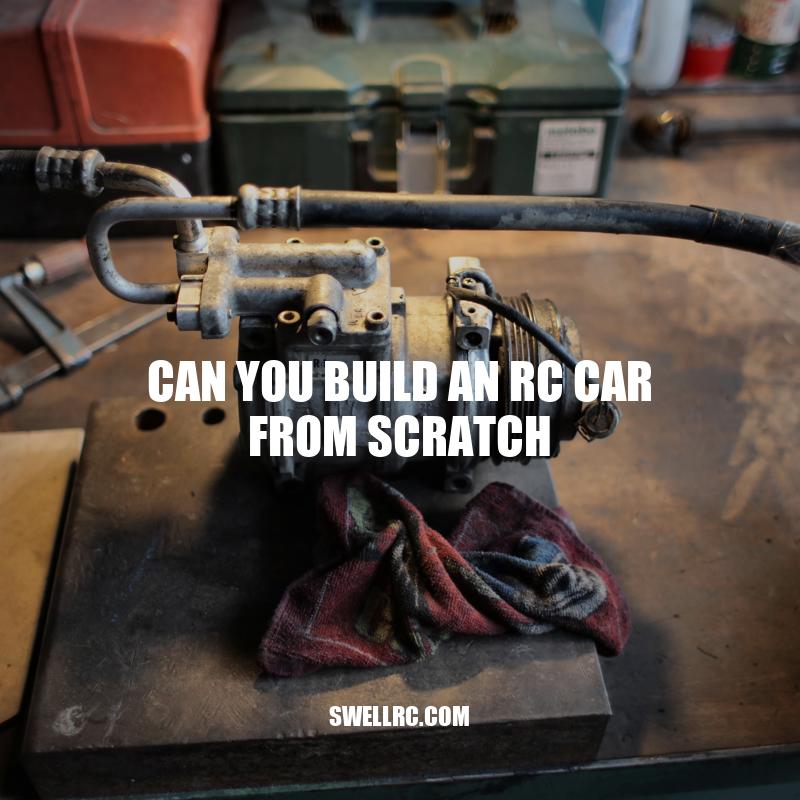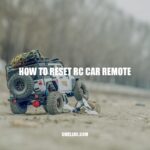Building an RC Car from Scratch: A Guide
Remote-controlled cars or RC cars are miniature vehicles that are operated using a remote control device. These cars, popularly known as RC cars, have become a craze among hobbyists and children alike. Hobbyists and enthusiasts are often interested in building their RC cars as it provides a sense of control over the entire build process. Building an RC car from scratch is not an easy feat, but it is doable with the right set of skills, tools, and knowledge. One of the most challenging aspects of building an RC car from scratch is understanding the individual components that make up the vehicle. Also, it requires breaking down each component and thoroughly exploring its functionality and importance in the system. Once you have a good understanding of the components, you can then proceed with assembling the car’s chassis and drivetrain. With that being said, we delve into what it takes to build an RC car from scratch and explore the key components necessary for a successful project.
Understanding the Parts
- RC car parts can be broken down into the following:
- Chassis
- Wheels and Tires
- Suspension System
- Drivetrain
- Electronic Components
- It is crucial to understand how each component interacts with the others for a successful build.
- Resources such as online forums and instructional videos can be used for information on individual parts and how they work together.
- Specialized websites such as HobbyPartz.com and TowerHobbies.com provide a range of parts and components required for your build.
Building an RC car from scratch requires a clear understanding of the various parts that make up the vehicle. Each part of the car is reliant on the other, and a small mistake can lead to poor performance. The following is a breakdown of the individual components required when building an RC car from scratch.
Chassis
The chassis serves as the RC car’s backbone and comes in various shapes and designs. It is often made from materials such as aluminum or carbon fiber.
Drivetrain
The drivetrain refers to the parts that move the RC car. It includes the motor, gear train, and transmission.
Electronic Components
The electronic components in an RC car include the receiver, transmitter, battery, and servos. These components work together to control the car’s movements.
It is important to note that resources such as online forums, instructional videos, specialized websites like HobbyPartz.com and TowerHobbies.com provide a wide range of instructional and parts resources to help with the build process.
Tools Required
The following is a breakdown of the tools required for building an RC car from scratch:
| Tool | Purpose |
|---|---|
| Screwdrivers | For tightening and loosening screws on the car’s components |
| Pliers | For holding and bending small parts |
| Hex drivers | For tightening hex bolts and screws |
| Nut drivers | For tightening and loosening nuts |
| Soldering iron | For attaching wires and electronic components |
Building an RC car from scratch requires a specific set of tools, all of which play an essential role in the build process. While some tools may be standard, others are specific to the build process. For example, the use of zip ties and heat shrink tubing is more prevalent in RC car building compared to regular automotive builds. It is essential to have the right tools to ensure your build is structurally sound and functions efficiently.
Apart from purchasing the right tools, it is also crucial to have a workspace that is well-lit, clean and spacious enough to accommodate the car’s size. Specialized websites can provide a range of beginner to expert build kits with detailed build guides for first-time builders. Building an RC car from scratch is not an easy task, but it can be an incredibly rewarding experience for those who enjoy tinkering and building things themselves.
What Do You Need to Build an RC Car From Scratch?
To build an RC car from scratch, you will need the following items:
- RC car kit
- Controller and receiver
- Battery and charger
- Motor and speed controller
- Servo
- Tires and wheels
There are many online resources that offer information on building RC cars from scratch. Websites like RC Car Action, RCCrawler, and RCGroups offer forums, tutorials, and product reviews to help you get started. You can also find RC car kits and accessories on Amazon and hobbyist websites like Tower Hobbies.
Building the Chassis
The chassis is the backbone of your RC car. Building the perfect chassis sets the foundation for an efficient and well-performing car. Here are some steps to follow when building your RC car chassis:
- Decide on the materials that you will use for the chassis.
- Measure and cut the frame rails to the desired length.
- Attach the side plates or cross members to the frame rails.
- Ensure that the chassis is perfectly square and level before welding or brazing the joints.
- Install the motor mount, suspension mounts, and shock mounts.
- Add the battery tray and electronics tray.
- Mount the bodyshell to the completed chassis using body clips, Velcro or magnets.
While building an RC car chassis at home can be intimidating and time-consuming, there are several websites and forums that offer detailed guides and tutorials to help you through the process. If building your own chassis from scratch is not your thing, there is a range of pre-built chassis kits available for purchase that cater to different skill and experience levels.
Is the chassis the body of a car?
No, the chassis is not the body of a car. The chassis is the frame that provides support for the engine, suspension and other components. The body of the car is the outer shell that encloses the passenger compartment and cargo area.
If you want to learn more about cars and their components, there are numerous website and products available online. To begin with, you can visit popular car blogs such as Car and Driver or Top Gear. Alternatively, if you prefer to read books or watch documentaries, consider searching for titles such as “The Car Book: Everything You Need to Know About Owning, Repairing, and Maintaining Your Car” or “The Secret Life of Machines: Cars”.
Building the Drivetrain
The drivetrain is another essential component of any RC car. It is responsible for the power transfer from the motor to the wheels, and also determines the type of power delivery to the wheels. Here are some steps to follow when building your RC car drivetrain:
- Choose the type of drivetrain that you want to use. Common options include two-wheel drive, four-wheel drive, belt drive, and direct drive.
- Select the motor, gearbox, and driveshaft to match the requirements of your drivetrain.
- Install the motor onto the motor mount and adjust the gear mesh.
- Connect the motor to the drivetrain using the driveshaft.
- Install the differential or spool to transfer power to the wheels.
- Add the wheels and tires to complete the drivetrain assembly.
- Test the drivetrain to check the power delivery and adjust any necessary components.
Building a drivetrain at home may require some experimentation and fine-tuning to achieve the desired performance. However, several forums and websites offer detailed tutorials and guides to help you through the process. If building your own drivetrain from scratch seems daunting, a wide range of off-the-shelf drivetrain kits are available to purchase. These kits come with instructions and pre-designed components to make the build process simpler and quicker.
What is a drivetrain on a RC car?
A drivetrain in a RC car refers to the system of components that transmit power from the motor to the wheels. It works by converting the rotational motion of the motor into linear motion in the wheels.
The key components of a drive train include the motor, gears, drive shafts, and differential. Each of these components work together to ensure that the vehicle moves smoothly, efficiently and quickly.
Depending on the type of RC car, there are different types of drivetrains available, including belt-driven and shaft-driven systems. It is important to choose the appropriate type of drivetrain for your particular RC car to ensure optimal performance.
For information on RC cars and their drivetrains, check out popular RC car websites such as Horizon Hobby or RC Planet.
Wiring and Electronics
The wiring and electronics component of building an RC car can be intimidating for beginners, but it is an essential part of the build process. Here are some steps to follow when building your RC car’s wiring and electronics system:
- Decide on the type of battery you want to use and choose the appropriate ESC (Electronic Speed Controller) to manage the power flow.
- Solder the ESC onto the motor and connect the battery to the ESC.
- Add the receiver and servo to control the car’s steering.
- Solder the receiver onto the ESC and connect it to the servo.
- Connect the ESC and receiver to the main power switch and battery.
- Install the transmitter and test the car’s electronics system.
It is crucial to handle electrical components with care and strictly follow safety guidelines when working with electronics. Several online communities and forums can assist you in setting up the wiring and electronics for your RC car, and specific kits containing all necessary components and instructions to make the process easier are also available.
What Electronics Do I Need for an RC Car?
To ensure your RC car operates flawlessly, there are a few essential electronics to consider. These include:
- A transmitter and receiver
- A battery and charger
- A motor and speed controller
- Servo and steering components
When purchasing these items, it’s important to identify compatible products for your specific RC car model. Some popular websites for RC car electronics include HorizonHobby.com, TowerHobbies.com, and Amazon.com. Make sure to read reviews and product specifications before making a purchase to ensure you get the best quality for your money.
Testing and Troubleshooting
After you have completed building your RC car, you will need to test it thoroughly to ensure that everything is working correctly. Here are some tips to follow when testing and troubleshooting your RC car:
- Test the range of your transmitter and receiver by driving the car around.
- Repeat the testing process to make sure there are no issues with the steering and the throttle.
- Check any mechanical components of the car, such as the wheels and axles, to ensure they are securely in place.
- Inspect the wiring and electronics system to ensure everything is correctly connected and functioning.
- If there are any issues, refer to online resources and forums or manufacturer instructions to troubleshoot the problem.
- Fix any issues before further testing or driving the car around.
Conclusion
Building an RC car from scratch may take time, skill, and knowledge, but it can be a rewarding experience for those who enjoy the challenge. Understanding the parts and tools required, building the chassis and drivetrain, and wiring and electronics are essential components of building an RC car from scratch. By following the steps outlined and taking safety into account, anyone can make a functional RC car. Once you have built and tested it successfully, it will provide endless hours of joy and excitement.



